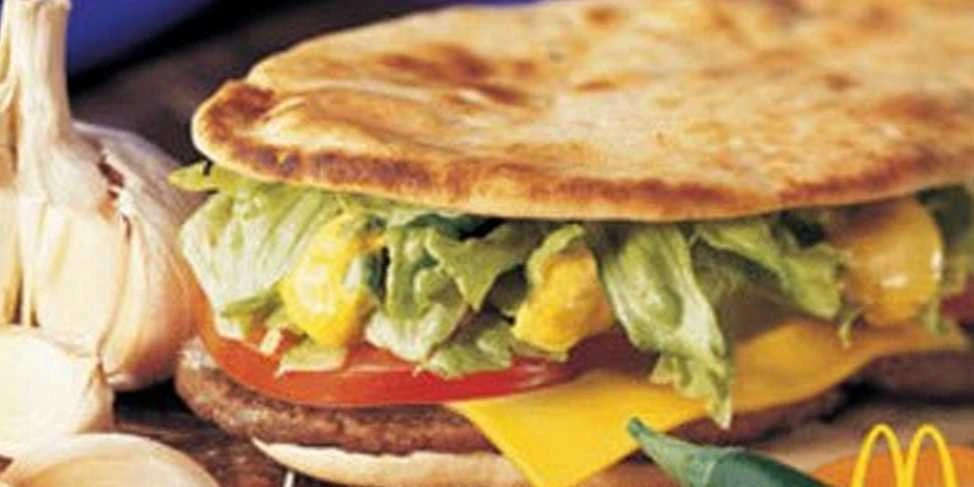The Burger With a Side of Insensitivity
For nearly a century, the name McDonald’s has been synonymous with hamburgers. The chain of fast food restaurants has been around since 1947, serving up patties of meat on buns since day one. And while the burger has been a mainstay of their menu, it hasn’t stopped the chain from coming up with innovative other products — the Filet o’ Fish, Chicken McNuggets, and, at times, the McRib have all graced the McDonald’s menu without much, if any, controversy.
But in 2002, McDonald’s offered a new product that didn’t go over so well: the McAfrika, seen below (via the McDonald’s Wiki):

As you can kind of make out, the McAfrika was very similar to a normal burger except that for the bread. It was released in Norway — and only Norway, thankfully — as part of the company’s celebration of the Olympics. McDonald’s introduced a few limited-time-only recipes featuring regionally-themed burgers, and the McAfrika was supposed to represent an entire continent. The burger, per Mashed, was “an ‘authentic African recipe’ of beef, cheese, and tomatoes inside pita bread,” citing McDonald’s own description vis-à-vis the recipe’s local authenticity.
But there were two major problems with the product. First, there is no such “authentic African recipe” that looks anything like the above. While you’ll find beef-stuff pitas in Egypt and in Lebanon, they’re not as common (to say the least) in the rest of Africa (and Lebanon isn’t even in Africa). In general, pitas are common in North Africa and the Middle East, but you won’t find them across the continent, and certainly not in southern Africa. McDonald’s, it seemed, just kind of made up a recipe and called it African.
And to make matters worse, many African nations were experiencing a famine at the time. As the Guardian reported at the time, “the launch of the new hamburger has infuriated the Norwegian equivalent of Christian Aid and the Norwegian Red Cross and generated a storm of bad publicity for the American fast-food giant. [ . . . ] Aid agencies trying to raise funds to stave off a famine in southern Africa say that the timing of the McAfrika marketing campaign is insensitive, crass and ill-considered and have demanded remedial action from McDonald’s.” How do you raise money for starving people when the world’s largest fast food chain is asserting that those very same people regularly indulge in specialty hamburgers?
To drive the point home, aid workers in Norway took their protest to the McDonald’s in their neighborhoods. One such worker, per CNN, spent the day “passing out free ‘catastrophe crackers’ to passers-by in protest. ‘This is a special, protein-rich cracker that we hand out to people in the hunger-stricken areas,’ she said,” noting that actual Africans were getting by with free food that more Europeans would quickly turn down. Others activists set up donation boxes outside the McDonald’s, and the restaurateur ultimately agreed to allow those donation boxes and accompanying signage to be placed inside their eateries.
But McDonald’s did not take the item off the menu early — the McAfrika ran its course on Norwegian menus. (It didn’t spread to other countries, though.) And six years later, it — somehow — made its return. As Yahoo! News notes, “McDonald’s 2008 McAfrica ditched the pita for a normal bun and instead relied on an ‘exotic African sauce’ of curry, mayonnaise, and chili powder to make it unique.” The backlash was similar, and the McAfrika hasn’t been seen since.
Bonus fact: In 2006, McDonald’s ran a promotion in Japan, giving out 10,000 USB drives that acted as mp3 players — all you needed to do was put the USB stick in your computer to unlock the music. It’s a great idea, but it had a big problem, as CNET explains: the USB sticks were also, accidentally (to be clear!) , loaded with “the ‘QQPass’ Trojan — an insidious program intended to steal login data from a Microsoft Windows PC.” McDonald’s set up a special customer support hotline for those with infected computers to help them through the problem.
From the Archives: Max the Knife: How cutlery helped slow McDonald’s ascent in Sweden.
